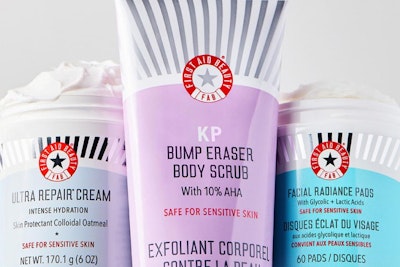First Aid Beauty
Skincare essentials for any skin type

First Aid Beauty's Sustainability Rating
Poor
Ingredients
First Aid Beauty has made ingredient commitments to lower its environmental impact, including by avoiding parabens, phthalates, microplastics, harmful suncare ingredients, and select other petrochemical-based ingredients. While it has made commitments, it still uses many ingredients that pose a significant threat to the climate, including other harmful suncare ingredients, other petrochemical-based ingredients, and uncertified palm oil or palm oil-derived ingredients. It carries products that have certifications from PETA Animal Test-free.
Containers & Packaging
Packaging is a big part of the industry's footprint, and First Aid Beauty doesn't share anything about its packaging materials. It hasn't made any efforts to concentrate its products or minimize its containers, which increases shipping emissions and packaging volumes. Its parent company, P&G, has made efforts to minimize the volume of material used in its secondary or tertiary shipping packaging, as well as to reduce virgin plastic in product containers.
Energy & Water Use
First Aid Beauty's parent company, P&G, shares information on its overall energy strategy but doesn't provide details at the brand-level. It uses a majority of renewable energy to power its production sites and corporate offices, and is targeting 100% renewable energy by 2030, for which it's on track. It implements energy efficiency measures in its production sites, but doesn't provide many specifics or detail if this extends to its corporate offices. It has water conservation initiatives in its production focused on water restoration and water positivity. First Aid Beauty has a global production span, which is standard for the industry.
Refill & Reuse
First Aid Beauty doesn't utilize any alternative models or methods to avert waste. It offers bulk sizes for some products, which may help reduce packaging waste.
Slow Cleaning
First Aid Beauty offers seasonal products or frequent releases, which can encourage overconsumption and production of excess inventory.
Marketing
Commons is still evaluating this brand's marketing emails.
Transparency & Reporting
First Aid Beauty doesn't appear to have a sustainability page or centralized source of relevant information, nor does it link customers to its parent company's comprehensive site. We hope for more accountability from large brands. P&G, its parent company, publishes a detailed annual report with a clear, impact-driven strategy and progress reporting. Its last annual report was published in 2023. First Aid Beauty shares a complete list of ingredients used in its products, on a per product basis.
Emissions Tracking
First Aid Beauty's parent company, P&G, internally measures and publicly reports its company-level emissions in partnership with, or with auditing from, a third party. It includes a breakdown by scope and identifies its top driver of emissions. The last reporting period was 2024. In this most recent update, its estimated emissions footprint was 187,883,256 tons CO2e.
Targets & Offsets
First Aid Beauty's parent company, P&G, has SBTi-approved emissions reduction targets for the medium-term (5-10 years). It has reported on its progress within the past year, and is on track for its scope 1 + 2 targets but not its scope 3 target. Its net zero commitment was recently removed by SBTi for not meeting the deadline to provide science-based targets. Commons couldn't find evidence that this brand offsets any emissions.
Supply Chain & Labor
First Aid Beauty's parent company, P&G, doesn't publish information about its supply chain partners. It publicly shares a supplier code of conduct, which prohibits forced labor, prohibits child labor, and includes environmental clauses. Its code of conduct doesn't disallow unauthorized subcontracting, ensure the right to collective bargaining where not allowed by law, ensure a living wage, or establish grievance mechanisms. P&G has a stated policy of regularly auditing its supply chain partners, which can mitigate human and environmental risks.
Advocacy
First Aid Beauty's parent company, P&G, discloses all of its trade association memberships, including those that are climate-obstructive. P&G is a member of 4 large climate-obstructive trade associations: U.S. Chamber of Commerce, Business Roundtable, Personal Care Products Council, American Chemistry Council. It isn't a member of advocacy organizations advancing climate policy. P&G employs state lobbyists with few fossil fuel aligned clients. P&G donated $500k-1M to climate-obstructive candidates or PACs from 2018-2024. Of this amount, 12.99% more was given to obstructive candidates or PACs than to pro-climate ones.
First Aid Beauty has a Poor rating due to an overall lack of sustainability efforts and disclosures. We expect more reporting and transparency from a brand of its size.
While First Aid Beauty successfully avoids select ingredients, it still uses many that pose a significant threat to the climate, including harmful suncare ingredients, petrochemical-based ingredients, and uncertified palm oil or palm oil-derived ingredients. It appears to rely on plastic packaging of a virgin or undisclosed source and doesn't utilize any alternative models or packaging minimization strategies, both of which contribute greatly to waste production and excess energy use. First Aid Beauty's parent company reports on its renewable energy use and emissions measurement, and it has SBTi-approved emissions reduction targets.
First Aid Beauty is owned by Procter & Gamble (P&G). P&G is holding back government climate action through its money and influence.
Our ratings are based on a scale from 1 (harmful) to 5 (best). How we rate →
https://www.firstaidbeauty.com/pages/about-us
https://us.pg.com/ingredients/
https://us.pg.com/blogs/global-recycling-day/
https://downloads.ctfassets.net/oggad6svuzkv/7PrU3Jq8gGsPAUl7fgZiR/919bd0309ccc76fd6365e047ba58ee5a/P_G_2023_Citizenship_Report_PDF.pdf
https://us.pg.com/environmental-sustainability/
https://www.pginvestor.com/esg/environmental/plastic-packaging/default.aspx
https://www.pginvestor.com/esg/environmental/forestry/paper-packaging/default.aspx
https://us.pg.com/blogs/closer-look-global-water-strategy/ https://s1.q4cdn.com/695946674/files/doc_downloads/esg/2022/water/P-G-Strategy-Toward-a-Water-Positive-Future.pdf https://www.pginvestor.com/esg/environmental/water/default.aspx
https://www.firstaidbeauty.com/collections/jumbos
https://www.pginvestor.com/esg/environmental/climate/default.aspx
https://s1.q4cdn.com/695946674/files/doc_downloads/esg/2023/Climate/pg-fy-22-23-assurance-statement.pdf
https://www.pginvestor.com/esg/environmental/climate/default.aspx#climate-scope-1-2
https://us.pg.com/blogs/net-zero-by-2040/
https://www.firstaidbeauty.com/pages/frequently-asked-questions
https://pgsupplier.com/assets/content/Documents/Supplier%20Sustainability/P&G%20Responsible%20Sourcing%20Static%20Document.pdf?v=20240619
https://us.pg.com/structure-and-governance/our-political-involvement/
https://fminus.org/lobbyists/
https://www.fec.gov/data/browse-data/
Get Rewards
Earn for sustainable purchases
Commons rewards you for sustainable purchases from all our Top Rated brands, plus thousands of everyday purchases — from thrift stores to public transit.
Learn more about rewards ->







